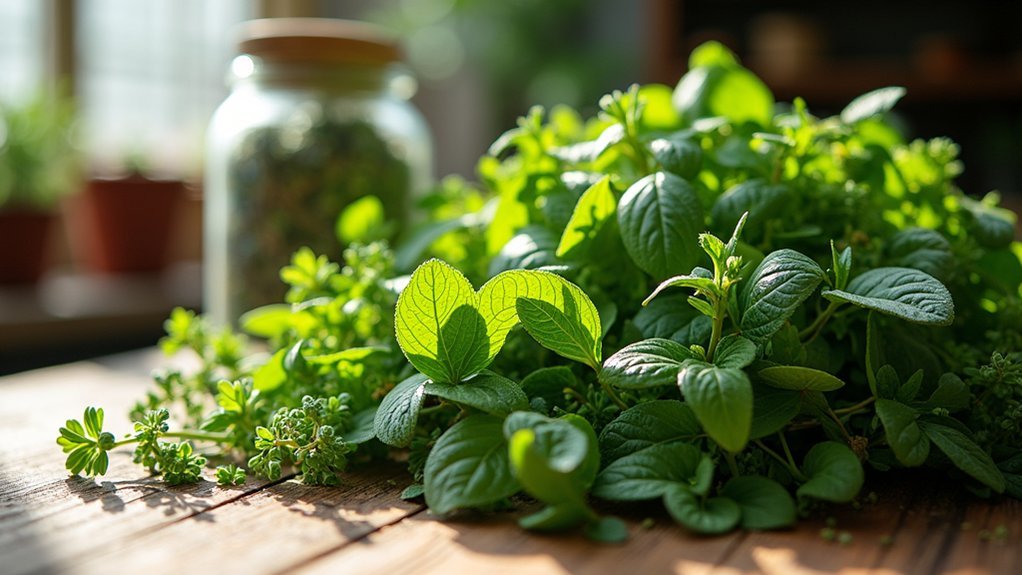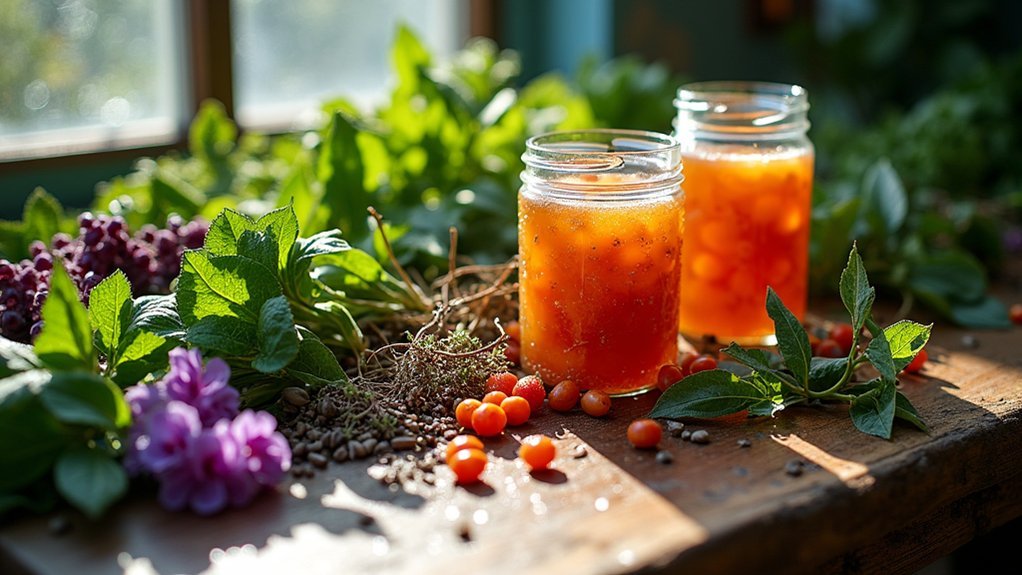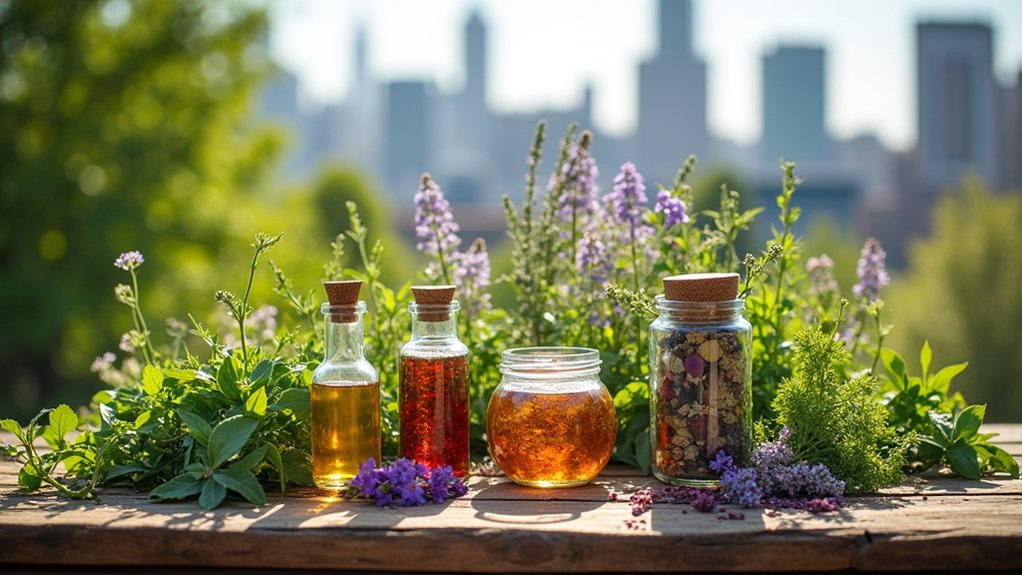Processing wild city plants makes financial sense because you'll save hundreds on groceries while accessing superior nutrition without transportation or pesticide costs. You can transform "weeds" into valuable preserves, teas, and fermented goods that create small business opportunities. Urban foraging democratizes access to fresh food, especially in underserved areas, and reduces your carbon footprint. The economic benefits of turning neglected urban spaces into valuable food resources are just the beginning of this sustainable practice.
Why Processing Wild City Plants Makes Cents Now

While many urbanites walk past "weeds" without a second glance, these overlooked plants offer untapped potential for your plate and wallet. By harvesting and processing wild edible plants growing in your neighborhood, you're tapping into a free food source that requires no fertilizers, pesticides, or transportation costs.
Urban foraging transforms neighborhood "weeds" into free, sustainable nutrition while saving money and reducing environmental impact.
As food prices climb, these native species can help buffer against food insecurity while providing exceptional nutrition. You'll find dandelions, lambsquarters, and purslane packed with vitamins and minerals that outshine many grocery store options.
Turn these urban treasures into preserves, dried herbs, or fermented goods, and you're creating valuable products from resources that would otherwise go unused.
This economical approach connects you to sustainable food systems while developing practical skills that enhance your self-sufficiency.
The Economic Value of Urban Foraging
Although overlooked by many city dwellers, urban foraging delivers substantial economic benefits beyond simply finding free food. You'll save hundreds of dollars annually on groceries while gaining access to nutritious wild plants that might otherwise be unavailable in your neighborhood.
The economic impact extends to community development. Neglected urban spaces transform into valuable resources when you identify edible plants growing there. Some enterprising foragers have turned this knowledge into small businesses, selling their wild harvests at farmers markets.
You're also contributing to a more sustainable food system by reducing transportation costs and carbon emissions. As chefs and consumers increasingly value local, wild ingredients, urban foraging creates entrepreneurial opportunities while democratizing access to fresh food, particularly in areas with limited grocery options.
Identifying Safe Wild Edibles in City Environments

You'll find the richest urban foraging opportunities in community gardens, undeveloped lots, and along waterways that aren't adjacent to high-traffic roads.
Always check with local environmental agencies about soil quality reports before harvesting from any urban location.
Steer clear of areas near industrial zones, railway tracks, and roadways with heavy traffic where plants may have absorbed harmful pollutants and heavy metals.
Urban Foraging Hotspots
Despite concrete jungles dominating the landscape, cities harbor surprising biodiversity in their parks, community gardens, and neglected lots where wild edibles flourish unnoticed.
You'll find these urban foraging hotspots teeming with nutritious plants like dandelions, chickweed, and purslane—species that thrive despite urban conditions.
Before harvesting these wild plants, you should research the land's history. Areas near industrial zones or busy roads may contain contaminated soil that affects plant safety.
Connect with local urban foraging groups to learn proper identification techniques and avoid toxic lookalikes.
Remember to practice sustainable harvesting when exploring these green pockets within the city. Always leave enough behind to guarantee regrowth, maintaining ecological balance in these valuable urban ecosystems that provide free, nutritious food right at your doorstep.
Avoiding Contaminated Areas
While urban foraging offers incredible opportunities for free, nutritious food, identifying safe harvesting locations remains your most essential consideration. Before picking any plants that grow in city environments, research the land's history to avoid contaminated areas. Use a reliable field guide to identify not only edible species but also their preferred habitats.
| Avoid Foraging Near | Why It's Unsafe |
|---|---|
| Major roadways | Vehicle pollution, heavy metals |
| Industrial zones | Chemical contamination, toxins |
| Train tracks | Herbicide treatments, oil residue |
| Landfills | Leaching pollutants, runoff |
Remember that plants like nettles absorb environmental toxins readily. Instead, seek out community gardens, well-maintained parks, and natural areas away from pollution sources. Always verify the ecological status of your target species to guarantee sustainable harvesting.
Essential Tools for Harvesting Urban Plants
You'll need sharp foraging knives or scissors to harvest urban plants cleanly, promoting healthy regrowth and minimizing damage.
Reliable plant identification guides, whether field guides or smartphone apps, help you distinguish edible plants from potential look-alikes that could be harmful.
Choose breathable, sturdy containers like baskets or cloth bags for your collected treasures, as proper storage prevents bruising and preserves freshness until processing.
Proper Foraging Equipment
Assembling the right tools before you head out to forage wild city plants can make the difference between a rewarding harvest and a frustrating experience.
Make certain you're equipped with sharp shears or scissors that deliver clean cuts, minimizing damage and encouraging regrowth—crucial given the role of wild plants in urban biodiversity during our climate crisis.
Carry a sturdy basket or cloth bag that allows proper air circulation, preventing your harvest from bruising.
Don't forget protective gloves when handling irritating species like stinging nettles, which can absorb soil contaminants.
A reliable field guide or identification app is vital for distinguishing edible plants from toxic look-alikes.
Finally, bring a small trowel for carefully harvesting roots and tubers with minimal ecosystem disturbance—respecting the environment guarantees sustainable foraging for years to come.
Plant Identification Guides
Because even the most experienced foragers can mistake toxic lookalikes for edible treasures, reliable plant identification guides serve as your essential companion for urban harvesting. Resources like "Wild Urban Plants of the Northeast" offer detailed descriptions, multiple photographs, and extensive information to guarantee you're collecting the right species.
You'll benefit from accessible content designed for foragers with minimal botanical knowledge. Each entry typically details the plant's cultural, medicinal, and ecological significance, deepening your appreciation of these urban survivors.
These guides highlight the resilience and ecosystem roles of common weeds, encouraging sustainable harvesting practices.
With proper identification guides in hand, you'll confidently navigate city environments, quickly recognizing edible opportunities while avoiding dangerous mistakes—transforming ordinary urban spaces into your personal pantry.
Storage Containers Matter
Selecting the right containers transforms your urban foraging experience from chaotic to efficient.
After identifying your urban treasures, how you store them determines their longevity and quality. Breathable mesh bags and glass jars maintain freshness by regulating air circulation and moisture, while food-safe materials like stainless steel and BPA-free plastics prevent chemical contamination.
For maximum preservation success:
- Label everything with plant name and harvest date – turning your pantry into an organized wild food inventory
- Vacuum-seal your containers to dramatically extend shelf life by preventing oxidation and preserving nutrients
- Choose containers that stack efficiently – transforming your kitchen into a personal wild food apothecary
Don't undermine your careful foraging with haphazard storage.
The right containers will preserve your urban bounty's flavor, nutrition, and medicinal properties.
Cleaning and Preparing City-Foraged Foods
Once you've harvested wild plants from urban environments, proper cleaning and preparation become essential steps that shouldn't be overlooked. Always rinse your foraged finds under running water to remove dirt, insects, and urban contaminants.
| Plant Type | Cleaning Method | Preparation Technique |
|---|---|---|
| Leafy Greens | Cold water rinse | Remove stems, sauté briefly |
| Berries | Gentle bath, pat dry | Remove stems, eat raw or cook |
| Mushrooms | Brush dirt, quick rinse | Slice, cook thoroughly |
| Nuts | Remove husks, rinse | Crack shells, roast to enhance flavor |
| Roots | Scrub thoroughly | Peel, slice, and cook well |
Avoid harvesting from polluted areas as plants absorb heavy metals from soil. Research each plant's specific preparation requirements—some need cooking to neutralize toxins while others are perfect raw. This sustainable practice not only saves money but connects you with your local ecosystem.
Drying Techniques for Wild Urban Herbs

When drying your wild urban herbs, place delicate foliage like mint or lemon balm in a shaded area to preserve their vibrant color and essential oils.
While electric dehydrators offer consistent temperature control and faster results for city foragers with limited space, natural sunlight drying works well for hardier herbs like rosemary or thyme when humidity levels are low.
You'll need to choose your method based on the herb type, available space, and local climate conditions to achieve ideal preservation results.
Shade-Drying Delicate Foliage
The gentle art of shade-drying preserves the vibrant essence of wild urban herbs that you've carefully foraged. By hanging your herbs in cool, dark, well-ventilated spaces, you'll protect their color, flavor, and precious essential oils from sunlight degradation.
Group your herbs in small bundles, secure stems with twine, and space them adequately to encourage airflow. The process takes one to two weeks—you'll know they're ready when leaves crumble easily to your touch.
- Savor the satisfaction of extending nature's bounty throughout the seasons
- Celebrate self-sufficiency by creating your own pantry of healing remedies
- Embrace the connection to urban wilderness each time you use your preserved herbs
Once dry, store your treasures in airtight containers away from light and heat to maintain potency year-round.
Dehydrators Versus Sunlight
Modern technology meets ancient practice in the ongoing debate between dehydrators and sunlight for drying your urban foraged herbs. While the sun costs nothing, dehydrators deliver consistent results year-round, preserving more flavor compounds and essential oils in your city harvests.
| Drying Method | Processing Time | Quality Outcome |
|---|---|---|
| Dehydrator | Hours | High nutrient retention |
| Sunlight | Days to weeks | Color and flavor loss |
| Dehydrator | Weather-independent | Minimal mold risk |
You'll find dehydrators particularly valuable in humid urban environments where sunlight drying often leads to mold issues. The initial investment pays off through higher-quality herbs with better market value. By controlling temperature and airflow precisely, you're ensuring maximum potency of your foraged treasures while saving considerable time—turning what might be a week-long process into just hours.
Fermenting Wild Plants: Methods and Benefits
Beyond simply preserving your foraged finds, fermenting wild plants transforms them into nutritional powerhouses while creating unique flavors you won't find in commercial products.
The lacto-fermentation process requires only salt, water, and your wild harvest—making it an accessible way to enhance urban foraging efforts.
When you ferment plants like dandelion greens or nettles, you're creating:
- Enhanced bioavailability of vitamins and minerals your body can better absorb
- Living probiotics that strengthen your gut health and immune system
- Sustainable, zero-waste condiments that connect you deeply to your local ecosystem
You'll notice these fermented additions elevate everyday meals while extending the usability of seasonal plants.
This traditional preservation method not only saves money but also deepens your relationship with the urban landscape around you.
Freezing Urban Foraged Foods for Year-Round Use

While seasonal abundance of wild urban plants offers momentary delight, freezing these foraged treasures extends their usefulness long after their growing season ends.
You'll preserve not just flavors but also essential nutrients when you properly blanch and freeze your wild harvests in airtight containers, maintaining their quality for up to a year.
Your grocery bills can decrease considerably when you tap into the free bounty growing in local parks and green spaces.
The freezer transforms ephemeral spring greens, summer berries, and fall mushrooms into sustainable year-round sustenance.
Beyond financial benefits, you're creating deeper connections to your local ecosystem while reducing food waste.
This practice supports food justice initiatives and sustainable eating habits—transforming your freezer into a storehouse of wild nutrition and ecological mindfulness.
Canning and Preserving Wild City Harvests
Canning and preserving release another dimension of urban foraging that transforms fleeting wild harvests into pantry staples with remarkable longevity.
When you properly process those wild blackberries, elderberries, or dandelion greens, you're extending their shelf life from days to years while maintaining nutritional integrity.
These preservation techniques offer significant economic advantages. You'll save money on specialty foods while building self-reliance with ingredients that are fundamentally free.
The process connects you to traditional food practices while reducing dependence on commercial supply chains.
- Security – Creating your own food reserves provides comfort during uncertain times
- Satisfaction – Opening a jar of summer's bounty during winter delivers unmatched joy
- Pride – Sharing your unique wild preserves with others celebrates your urban foraging skills
Creating Value-Added Products From Urban Plants

Transforming raw urban harvests into specialty products releases their full economic potential and extends their usefulness beyond basic consumption.
You'll find that common plants like dandelions, purslane, and wild garlic can become distinctive jams, jellies, and herbal teas that command premium prices in local markets.
As consumers increasingly seek sustainable, locally-sourced options, you're positioned to meet this demand with artisanal wild-plant products.
By hosting processing workshops, you'll foster community engagement while teaching valuable skills that boost the local economy.
Your value-added products can also advance food justice by providing nutritious, affordable options to food-insecure neighborhoods.
This entrepreneurial approach creates a win-win scenario: you'll develop profitable micro-businesses while promoting ecological benefits of native plants and reducing food waste in your community.
Building Community Through Shared Harvesting
Because urban foraging naturally brings people together, organized harvesting events create powerful community bonds that transcend social barriers.
When you join neighborhood harvesting initiatives, you're not just collecting food—you're cultivating relationships with diverse neighbors who share your interest in local ecology.
These shared experiences transform communities through:
- Meaningful connection – Replace screen time with face-to-face interactions while learning from each other's knowledge about wild edibles.
- Collective pride – Celebrate your neighborhood's unique botanical identity and create a shared sense of place and purpose.
- Mutual support – Transform surplus harvests into community resources, ensuring everyone benefits from nature's bounty.
You'll discover that processing wild plants together builds both food security and the social fabric that makes neighborhoods resilient and vibrant.
Legal Considerations for Urban Foraging
While the urban landscape offers abundant foraging opportunities, you'll need to navigate a complex web of regulations before harvesting that tempting mulberry tree or wild garlic patch.
Research your local ordinances first, as they vary considerably between municipalities. Many cities designate specific areas where foraging is permitted while restricting activities in other public spaces to protect native ecosystems.
Remember that harvesting on private property without permission constitutes trespassing.
Adopt sustainable practices by limiting your harvest and avoiding endangered species. This approach aligns with most urban guidelines and helps maintain healthy plant populations for future foragers.
Be mindful of potential liability issues too. Plants growing near roads or in industrial areas may contain contaminants, creating health risks you'd rather avoid.
Seasonal Calendars for City Plant Harvesting
When you understand nature's rhythms in urban environments, your foraging success multiplies exponentially. By tracking seasonal changes, you'll discover that early spring brings tender dandelion greens and nettles, while late summer offers blackberries and elderberries at peak ripeness.
Developing your personal harvesting calendar connects you to urban ecosystems in powerful ways:
- You'll harvest at prime times, ensuring maximum flavor and nutrition from each plant.
- You'll naturally practice sustainable foraging, allowing plants time to reproduce and thrive.
- You'll witness the intricate relationships between urban plants and wildlife throughout the year.
Your awareness of these natural cycles transforms random plant spotting into purposeful harvesting.
Consider joining community foraging events to enhance your knowledge and share discoveries with fellow urban wildcrafters.
Frequently Asked Questions
How Do Pesticides From Nearby Landscaping Affect Foraged Urban Plants?
Pesticides from nearby landscaping can contaminate foraged urban plants. You'll find these chemicals may drift onto wild edibles, potentially harming your health. It's wise to wash thoroughly or avoid collecting near treated areas.
Can Heavy Metal Contamination in City Soil Be Removed From Plants?
You can't fully remove heavy metals from plants grown in contaminated soil. They're often integrated into plant tissues. Instead, you're better off washing thoroughly, peeling roots, or growing in raised beds.
What Insurance Do I Need When Selling Foraged City Products?
You'll need product liability insurance to protect against contamination claims, general liability for business operations, and possibly commercial property insurance. Check local regulations as they vary by location for selling foraged products.
How Do I Approach Private Property Owners About Harvesting Their Plants?
You'll want to be respectful and direct. Introduce yourself, explain your foraging purpose, offer to share harvested items or profits, and get permission in writing before touching any plants on their property.
Are There Mobile Apps Specifically Designed for Identifying Urban Edibles?
Yes, you'll find several apps like Seek, iNaturalist, PlantNet, and Wild Edibles that help identify urban edible plants. They use image recognition to instantly tell you which plants are safe to harvest and consume.
In Summary
You've discovered a practical pathway to sustainability right at your doorstep. By turning urban plants into valuable resources, you're not just saving money—you're reclaiming ancient knowledge while creating modern solutions. Whether you're making tinctures from dandelions or jams from urban berries, you're participating in a growing movement that transforms "weeds" into wealth. Start small, learn constantly, and watch your urban harvesting skills become increasingly valuable.





Leave a Reply